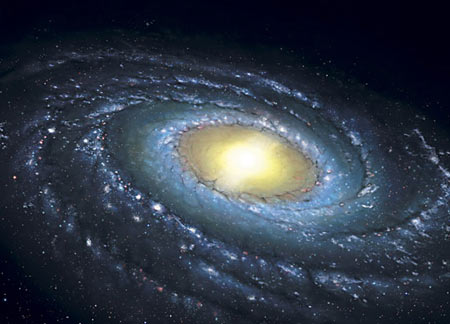The Milky Way has no numerical date
Some small galaxies have collided with the Milky Way. Similar clashes still occur in the future, but they cannot destroy the Milky Way as predicted by many scientists.
Space.com said, about 20-25 small galaxies revolving around the Milky Way. In fact, they are small star groups, so they do not cause a big impact when hitting the Milky Way. However, some pessimists argue that if many satellite galaxies collide with the Milky Way at the same time, our galaxy may be torn apart.
To understand the problem, Ohio University astronomers use a computer model to simulate the galaxy's collision with satellite galaxies. The model shows that such clashes only create thin disk-shaped material belts around small galaxies, not tearing the Milky Way.

Galaxy.(Photo: Current.com)
' Our models show that spiral galaxies like the Milky Way are not destroyed when they collide with satellite galaxies ,' said Stelios Kazantzidis, the leader of the research team.
Although the Milky Way is not in danger due to collisions with dwarf galaxies, astronomers predict it will clash with Fairy Female - the closest spiral galaxy and also roughly the same size. The encounter can happen in a few billion years.
Fortunately, collisions between two galaxies will not put an end to civilization on earth. All stars in galaxies are so far apart that they will not crash into each other when that event takes place. So the sun (a star) continues to exist and illuminate the planet. In fact, the merger between the two galaxies also creates many new stars.
- Enjoy the pure Milky Way season
- Why can expired food still be edible?
- Fun little-known facts about the Milky Way
- The mass of the Milky Way
- The Milky Way had 'devoured' another galaxy billions of years ago
- Date of death depends on the date of birth?
- The best method to enhance old-age memory
- The Milky Way might contain 100 million black holes
- How to read the expiry date on cosmetics - simple idea that turns out not everyone knows
- The Milky Way has died once, we live in its second
- New map of the Milky Way
- Close up of the Milky Way's
 Van Allen's belt and evidence that the Apollo 11 mission to the Moon was myth
Van Allen's belt and evidence that the Apollo 11 mission to the Moon was myth The levels of civilization in the universe (Kardashev scale)
The levels of civilization in the universe (Kardashev scale) Today Mars, the sun and the Earth are aligned
Today Mars, the sun and the Earth are aligned The Amazon owner announced a secret plan to build a space base for thousands of people
The Amazon owner announced a secret plan to build a space base for thousands of people